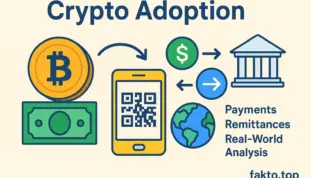Crypto Adoption: Payments, Remittances, and Real-World Analysis
The Hidden Rails: Analyzing How Next-Gen Crypto Infrastructure is Finally Making Payments & Remittances ‘Real’
The speculation era is over. Crypto’s value is no longer measured in moonshots or meme coins—it’s measured in milliseconds and basis points. The Utility Era has arrived, and it’s not waiting for permission. From street vendors in Lagos to freelancers in Lisbon, crypto is quietly displacing legacy rails with something faster, cheaper, and final.

This article isn’t a listicle. It’s a deep dive into the infrastructure—Layer 2 protocols, stablecoins, and economic mechanics—that make everyday crypto payments not just possible, but superior. We’re dissecting the rails beneath the hype, and showing how they’re already reshaping payments, remittances, and small-business finance.
Section 1. Beyond the Gas Fee: Why Retail Adoption Relies on L2 Speed and Satoshis
Let’s start with the elephant in the room: Ethereum gas fees. For years, they’ve been the punchline of crypto adoption jokes. But the real barrier isn’t just cost—it’s latency. Nobody wants to wait 45 seconds for a sandwich payment to confirm. Retail adoption demands speed, finality, and frictionless UX. That’s where Layer 2 (L2) solutions come in.
The Lightning Network is the financial system’s fiber optic cable. It’s not just fast—it’s instant. Built atop Bitcoin, Lightning abstracts away the bulk of on-chain congestion by settling transactions off-chain and batching them later. Think of it like a cryptographic accountant that verifies micro-payments in real time, then settles the books in bulk. This is how we go from thinking in whole Bitcoins to thinking in satoshis—tiny units that feel cheap, fast, and usable.
Let’s compare directly: Lightning wallet vs. Visa transaction speed. Visa settles in batches, often with a 24–48 hour delay. Lightning settles instantly. Visa payments are reversible—subject to chargebacks and fraud. Lightning payments are final. For merchants, this isn’t just a technical detail—it’s a business incentive. Finality means no clawbacks, no disputes, no middlemen.
And the UX layer? That’s where mobile wallets and crypto payment apps shine. Apps like Strike, Muun, and Phoenix make Lightning feel like Venmo—tap, scan, done. The complexity of channels, liquidity, and routing is abstracted away. For the user, it’s just a payment. For the merchant, it’s instant settlement with near-zero fees.
Retail crypto adoption isn’t waiting for Ethereum 2.0. It’s already happening on L2 rails that prioritize speed, finality, and usability. The gas fee debate is yesterday’s problem. Today’s solution is satoshis moving at the speed of light.
Section 2. Dismantling the Banks: Stablecoins as the Superior Infrastructure for Cross-Border Transfers
Remittances are the killer app for crypto. Not NFTs. Not DeFi. Just sending money home—fast, cheap, and reliably. Traditional systems like SWIFT are slow, expensive, and cartelized. They rely on correspondent banks, nested fees, and opaque FX spreads. Stablecoins dismantle that entire architecture.

Let’s be clear: USDC and USDT aren’t speculative assets—they’re infrastructure. Their stability eliminates volatility risk, which is essential for family remittances. When an immigrant sends $200 to their family, they don’t want it to arrive as $178 because of market swings. Stablecoins lock in value, and move it across borders in seconds.
Here’s a narrative example: Maria, a nurse in Spain, sends €300 monthly to her parents in Colombia. Through SWIFT, that transfer costs ~6% in fees and takes 2–3 days. Through Lightning + USDT, it costs under 1% and arrives in minutes. That’s not just better—it’s economically transformative.
| Payment Rail | Average Fee (% of transfer) | Settlement Time |
|---|---|---|
| SWIFT | 5–7% | 2–5 business days |
| Western Union | 6–10% | Same day (cash pickup) |
| Lightning Network (L2/P2P) | <1% | Instant |
| Stablecoin Rail (Avg. Exchange Fee) | 1–2% | Minutes |
But the real innovation isn’t just sending crypto—it’s converting it. Liquidity providers play a crucial role in crypto remittances. Platforms like Binance P2P, Paxful, and LocalBitcoins allow recipients to instantly swap stablecoins for local fiat, often at better rates than banks. These decentralized exchanges are the on-ramp and off-ramp infrastructure that make crypto remittances usable, not just possible.
Cross-border transfers aren’t a niche use case. They’re a $700B+ global market. And crypto rails are already eating into it—not with hype, but with calculated utility. Stablecoins are the new SWIFT. And they don’t need permission to operate.
Section 3. The Merchant Equation: Calculating the ROI of Small-Business Crypto Acceptance
Merchants don’t care about blockchains. They care about margins. For small businesses, every percentage point matters—and crypto rails offer a compelling ROI when measured against traditional payment processors.

Let’s break it down. Credit card processors charge 2–3% per transaction, plus chargeback risk and settlement delays. Crypto payment processors like BitPay or Coinbase Commerce flip that model. The merchant never touches the crypto—they receive instant fiat settlement, often at lower fees, and with zero chargeback exposure.
This isn’t about ideology—it’s about efficiency. In high-inflation environments, holding fiat is a liability. Crypto rails allow merchants to accept payments, convert instantly, and avoid local currency depreciation. That’s not speculation—it’s survival.
Setting up crypto acceptance is simpler than most think. Platforms offer plug-and-play integrations for Shopify, WooCommerce, and even physical POS systems. The volatility risk? Eliminated. The processor converts in real time, locking in the fiat value at the moment of sale.
Let’s look at a high-value use case: rent payments. Landlords accepting crypto aren’t chasing trends—they’re reducing fraud. ACH transfers can be reversed. Checks bounce. Crypto payments are final. For recurring transactions, finality equals reliability.
| Payment Type | Volatility Risk (for Merchant) | Chargeback Risk | Avg. Processing Fee |
|---|---|---|---|
| Credit Card | None | High | 2.5–3% |
| ACH Transfer | None | Medium | 1–1.5% |
| Bitcoin (Direct) | High | None | <1% |
| Stablecoin (Instant Fiat Conversion) | None | None | 0.5–1% |
Crypto acceptance isn’t a gimmick—it’s a calculated upgrade. For small businesses, it’s about reducing fees, eliminating fraud, and gaining control over settlement. The merchant equation is simple: lower cost + higher finality = better ROI.
Section 4. New Frontiers of Utility: Identity, DAOs, and Value Capture
Crypto isn’t just money—it’s infrastructure. Beyond payments, it’s quietly reshaping identity, governance, and asset ownership. These aren’t future promises—they’re live use cases.
Let’s start with donations. Traditional NGOs operate in opacity. Funds are pooled, spent, and reported—sometimes. Charitable DAOs flip that model. Every donation is on-chain. Every expenditure is traceable. Governance is transparent, and decisions are made by token holders. It’s not just accountability—it’s programmable trust.
Peer-to-peer crypto payments are also evolving. In gaming ecosystems, community pools, and micro-economies, digital assets serve as more than currency. They’re credentials, tickets, and identities. Soulbound Tokens (SBTs), for example, represent non-transferable achievements or affiliations. Think of them as blockchain-based diplomas or membership badges—verifiable, immutable, and personal.
And then there’s real estate. Tokenized Real-World Assets (RWAs) allow fractional ownership of property. Instead of buying a whole apartment, users can own 0.1% of a building—earning yield, voting on maintenance, and trading their stake. It’s liquidity for the illiquid. The blockchain becomes the balance sheet of the physical world.
Crypto isn’t replacing institutions—it’s reformatting them. Identity becomes portable. Governance becomes transparent. Ownership becomes divisible. These aren’t buzzwords—they’re functional upgrades. And they’re already live in ecosystems like Gitcoin, CityDAO, and RealT.
The frontier isn’t speculative—it’s infrastructural. Crypto is quietly embedding itself into the fabric of real-world systems, not as a disruptor, but as a better format. The question isn’t “will it work?”—it’s “how fast will it scale?”
Section 5. The Final Hurdles: Regulatory Friction and Mass Adoption
Let’s be blunt: the tech is ready. The rails are laid. The trains are running. But regulators are still arguing over the color of the tickets.
Crypto’s biggest barrier isn’t latency or volatility—it’s paperwork. Every time a merchant accepts crypto, they risk triggering a capital gains event. Every rent payment, every invoice, every coffee—potentially taxable. That’s not just annoying. It’s paralyzing.
Imagine a small business owner in Texas accepting USDC for a $500 invoice. If the coin’s value fluctuates between receipt and conversion, they’re expected to report the delta. Multiply that by 100 transactions a month, and you’ve got a tax headache worthy of a CPA’s nightmare.
Now layer in KYC and AML requirements. A landlord accepting crypto rent payments in the U.S. may be legally obligated to verify the source of funds, screen for sanctioned wallets, and maintain compliance logs. That’s not friction—it’s barbed wire.
Crypto has solved the speed problem. Regulators must now solve the friction problem. The infrastructure is lean, fast, and global. But until the legal frameworks catch up, mass adoption will remain a patchwork of brave pioneers and cautious bystanders.
What’s needed is clarity. Not just on taxation, but on classification. Is USDC a currency? A commodity? A security? The answer shouldn’t depend on which agency you ask. Until then, crypto adoption will continue to outpace crypto regulation—and that gap will define the next five years.
Conclusion: The Calculated Utility of a Decentralized Future
Crypto isn’t waiting for permission. It’s already embedded in the daily lives of millions—sending money, accepting payments, verifying identity, and capturing value. The infrastructure is here. It’s fast, final, and economically superior.
Layer 2 protocols like Lightning have solved the speed problem. Stablecoins have solved the volatility problem. Liquidity providers have solved the conversion problem. What remains is regulatory clarity and economic education.
This isn’t a revolution—it’s a replacement. The old rails are slow, expensive, and fragile. The new rails are lean, programmable, and global. Businesses and individuals now face a choice: keep riding the legacy train, or switch to the crypto bullet.
And make no mistake—the switch is happening. Not because of ideology, but because of math. Lower fees, faster settlement, final transactions. That’s not hype. That’s utility. And it’s already winning.
The decentralized future isn’t coming. It’s already here. The question is: are you building on it?
MANDATORY DISCLAIMER
This article is for informational and analytical purposes only and does not constitute financial, investment, or legal advice. Cryptocurrency investments are subject to high volatility and risk, including the potential for complete loss of capital. Always conduct your own research (DYOR) and consult with a certified financial professional before making any investment decisions. The author and publisher are not liable for any losses incurred based on the analysis provided.
